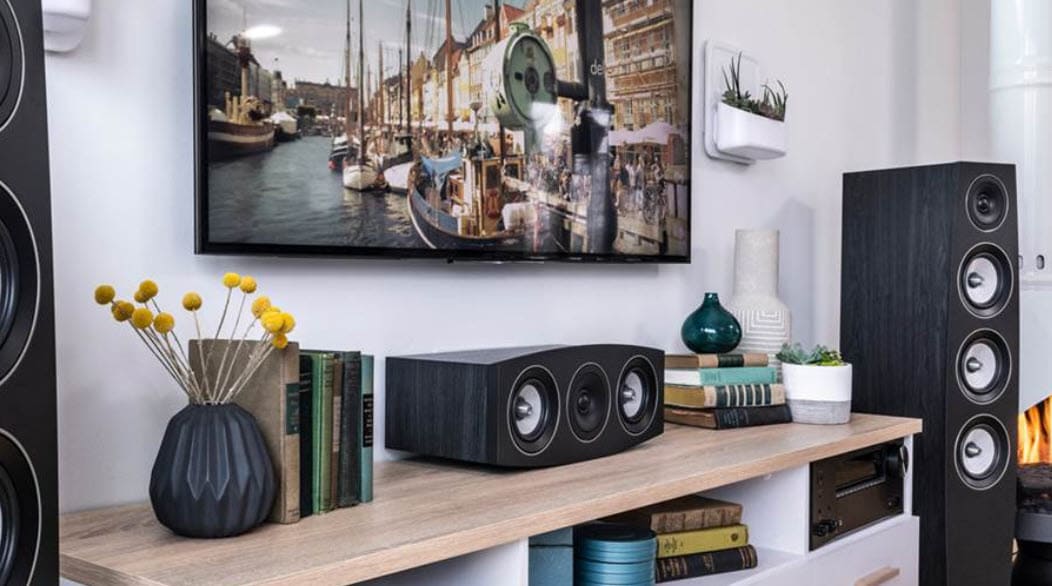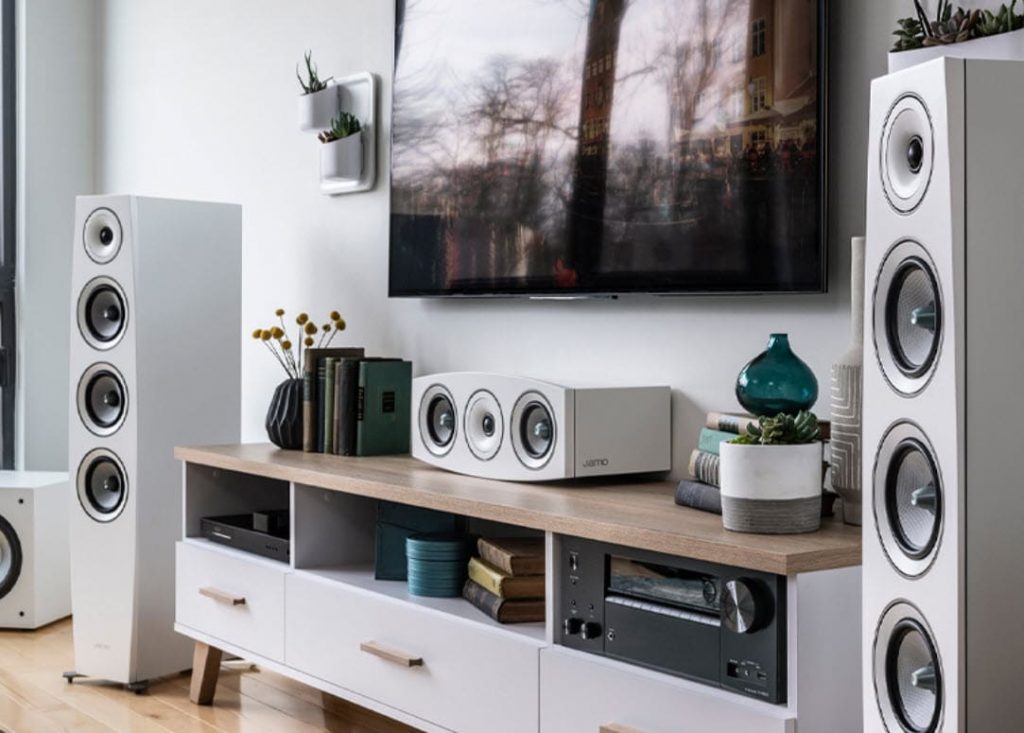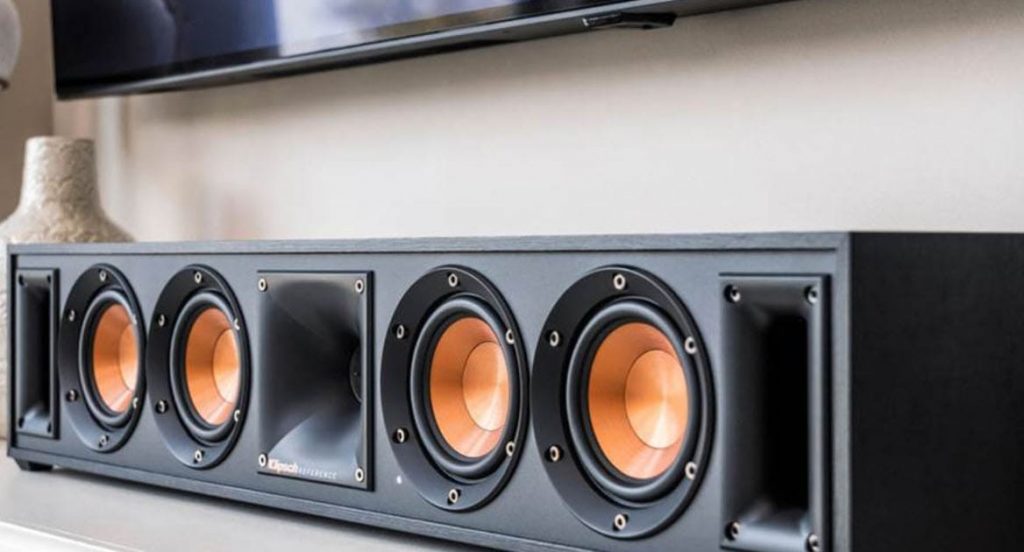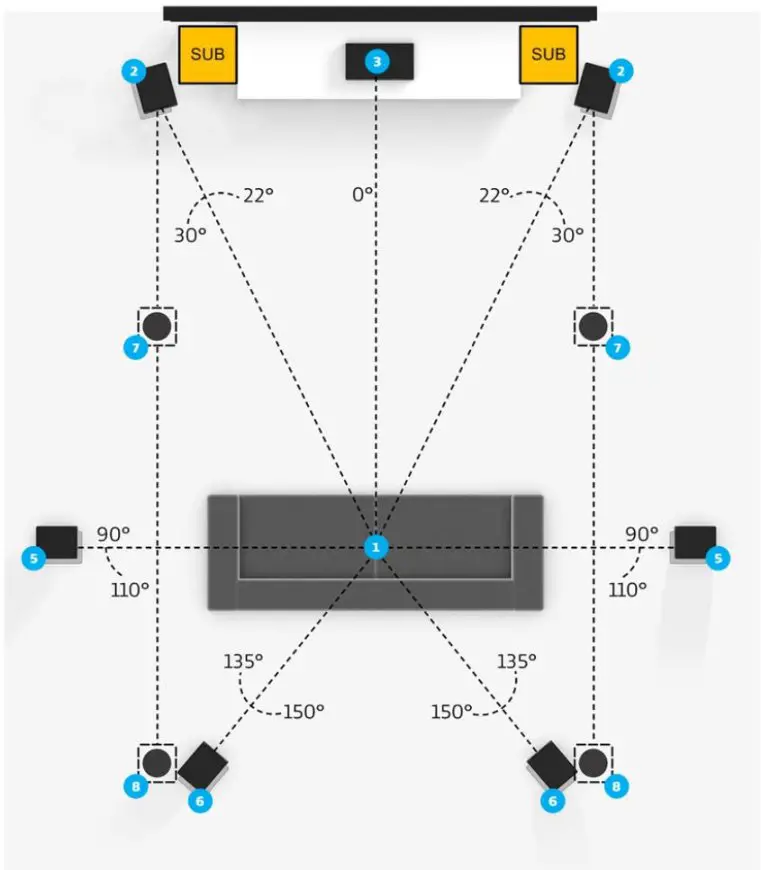The Role of the Center Channel Speaker in Surround Sound
Welcome to our discussion on the role of the center channel speaker in a surround sound system. If you’re an audiophile or a home theater enthusiast, you know the importance of having high-quality sound in your setup. And when it comes to creating a truly immersive audio experience, a center channel speaker is an essential component.
I. Introduction
But what exactly is a center channel speaker? Simply put, it is a speaker designed specifically for reproducing dialogue and vocals in movies and TV shows, as well as music in a home theater setup. It is usually placed directly above or below the television, and its main function is to help create a seamless and cohesive soundstage.
So, why is a center channel speaker so important in a surround sound system? To understand this, let’s first take a look at how a surround sound system works. In a typical setup, you have left and right front speakers left and right surround speakers and a subwoofer.
These speakers work together to create a multidimensional sound experience, with the left and right front speakers handling the majority of the soundstage. However, when it comes to dialogue and vocals, the center channel speaker takes over, ensuring that the sound is clear and focused.
In other words, the center channel speaker acts as the anchor of the surround sound system, providing a consistent and clear audio experience no matter what you’re watching or listening to. Without a high-quality center channel speaker, you risk having muddled or distorted dialogue and vocals, which can greatly detract from your overall listening experience.
In the next section, we’ll take a closer look at what a center channel speaker is used for and how it works in a surround sound system. Stay tuned!
II. What is a center channel speaker used for?
As we mentioned in the introduction, the main purpose of a center channel speaker is to reproduce dialogue and vocals in movies and TV shows. This is especially important for creating an immersive and realistic audio experience when watching films or TV shows with a lot of dialogue.
Without a center channel speaker, you risk having dialogue that sounds disconnected or out of place, which can be distracting and take away from your enjoyment of the content.
But the center channel speaker is not just limited to reproducing dialogue and vocals. It also plays a crucial role in music reproduction in a home theater setup. Whether you’re listening to a live album or a movie soundtrack, the center channel speaker helps to create a cohesive and balanced soundstage.
So, why is the center channel speaker so effective at reproducing both dialogue and music? It all comes down to its placement and design. As we mentioned earlier, the center channel speaker is usually placed directly above or below the television, which allows it to reproduce sound that is directly in front of you. This is especially useful for dialog and vocals, as it helps to create a more realistic and natural soundstage.
Additionally, many center channel speakers are designed with multiple drivers, which allows them to handle a wide range of frequencies and create a more dynamic and detailed sound. This makes them ideal for both dialog and music reproduction, as they can accurately reproduce the nuances and subtleties of both types of sound.
III. How does a center channel speaker work in a surround sound system?
Now that we’ve covered what a center channel speaker is used for, let’s take a closer look at how it works in a surround sound system.
As we mentioned earlier, the main function of the center channel speaker is to reproduce dialogue and vocals in movies and TV shows. But it also plays a crucial role in reproducing sound effects, especially those that are centered on the soundstage.
For example, when a car drives by on the screen, the sound of the engine should come from the center channel speaker, as it is directly in front of you. This helps to create a more realistic and immersive audio experience.
But the center channel speaker doesn’t just work on its own. It also complements the left and right front speakers, which handle the majority of the soundstage. Together, the three speakers work to create a seamless and cohesive soundstage that envelops you in sound.
So, how does the center channel speaker complement the left and right speakers? One way is through the use of timbre matching. This refers to the ability of the center channel speaker to match the tonal characteristics of the left and right front speakers.
This helps to create a more cohesive and natural soundstage, as the sound from all three speakers blends together seamlessly.
Another way that the center channel speaker complements the left and right speakers is through the use of phase alignment. This refers to the timing of the sound waves produced by the speakers. By ensuring that the sound waves are in phase with each other, the center channel speaker helps to create a more coherent and focused soundstage.
IV. Center channel speaker placement
Proper placement of the center channel speaker is crucial for achieving optimal sound quality and creating a seamless and cohesive soundstage.
One tip for optimal placement is to align the center channel speaker with the left and right front speakers. This helps to create a more cohesive and focused soundstage, as the sound from all three speakers is more evenly distributed.
Another tip is to aim the center channel speaker towards the listening position. This helps to ensure that the sound is focused and directed toward the listener, rather than spreading out and becoming diffuse.
It’s also important to consider the height of the center channel speaker. In general, it should be placed at the same height as the left and right front speakers. This helps to create a more cohesive and natural soundstage, as the sound from all three speakers is more evenly distributed.
However, it’s important to note that the ideal placement will vary depending on the specific layout of your home theater setup. For example, if you have a high ceiling or a particularly large room, you may need to adjust the placement of the center channel speaker to achieve the best sound quality.
In conclusion, proper placement of the center channel speaker is crucial for achieving optimal sound quality in a surround sound system. By aligning it with the left and right front speakers and aiming it towards the listening position, you can create a seamless and cohesive soundstage that envelops you in sound. In the next section, we’ll wrap up our discussion on the role of the center channel speaker in a surround sound system.
V. 5 Things to Consider When Choosing a Center Channel Speaker
If you’re in the market for a new center channel speaker, there are a few key things to consider to ensure you get the best one for your needs.
- Size and placement: One important factor to consider is the size and placement of the center channel speaker. You’ll want to choose a speaker that is a good fit for your home theater setup and fits in with your decor. Additionally, you’ll want to ensure that the speaker can be properly placed in relation to your left and right front speakers for optimal sound quality.
- Frequency response: The frequency response of a speaker refers to the range of frequencies that it can reproduce. A speaker with a wide frequency response will be able to accurately reproduce a wider range of sounds, including both high and low frequencies. This is especially important for a center channel speaker, as it is responsible for reproducing dialogue and vocals, which span a wide range of frequencies.
- Power handling: Another important factor to consider is the power handling of the speaker. This refers to the amount of power that the speaker can handle without distortion. A speaker with a higher power handling capability will be able to produce louder and more dynamic sounds without sacrificing sound quality.
- Driver configuration: The driver configuration of a speaker refers to the number and type of driver that it has. A center channel speaker with multiple drivers will be able to handle a wider range of frequencies and create a more dynamic and detailed sound.
- Price: Of course, price is always a consideration when shopping for a new center channel speaker. Determine your budget and look for a speaker that offers the best combination of features and performance within your price range.
Ⅵ. Conclusion
We’ve covered the important role that the center channel speaker plays in a surround sound system. As we’ve seen, the center channel speaker is responsible for reproducing dialogue and vocals in movies and TV shows, as well as music in a home theater setup. It helps to create a cohesive and seamless soundstage and is the anchor of the surround sound system.
Proper placement of the center channel speaker is crucial for achieving optimal sound quality and creating a cohesive and immersive audio experience. And while there are different types of center channel speakers to choose from, having a high-quality speaker is essential for enjoying the best possible sound.
So, if you’re looking to upgrade your home theater setup or just want to improve the sound quality of your favorite movies and TV shows, consider investing in a high-quality center channel speaker. You’ll be rewarded with clearer and more focused dialogue and vocals, and a more immersive and cohesive soundstage.
VII. Related Questions
Can you use any speaker for the center channel?
Technically, you can use any speaker as a center channel speaker in a home theater setup. However, not all speakers are equally suitable for this purpose.
A center channel speaker is specifically designed to reproduce dialogue and vocals in movies and TV shows, as well as music in a home theater setup. It is usually placed directly above or below the television and helps to create a cohesive and seamless soundstage.
In order to be effective as a center channel speaker, a speaker should have a wide frequency response and be able to accurately reproduce a wide range of frequencies. It should also be able to handle a high volume level without distorting the sound.
While you can use any speaker as a center channel speaker, using a speaker that is not specifically designed for this purpose may result in suboptimal sound quality. For the best results, it is recommended to use a dedicated center channel speaker that is designed specifically for this purpose.
Can I use a soundbar as a center channel speaker?
Yes, a soundbar can be used as a center channel speaker in a home theater setup. A soundbar is a type of speaker that includes multiple drivers and an amplifier in a single, compact unit. It is designed to be placed below or above the television and can be used to reproduce sound for movies, TV shows, and music.
Some soundbars even include a dedicated center channel speaker, which is specifically designed to reproduce dialogue and vocals. In this case, the soundbar can serve as both a left and right front speaker and a center channel speaker, creating a cohesive and seamless soundstage.
However, it’s important to note that a soundbar may not offer the same level of performance as a dedicated center channel speaker. While soundbars are a convenient and easy-to-use option, they may not be able to produce the same level of detail and clarity as a separate center channel speaker.
Ultimately, whether a soundbar can serve as an effective center channel speaker will depend on your specific needs and preferences. Consider factors such as size, convenience, performance, and budget to determine the best fit for your home theater setup.
Is a center channel good for music?
A center channel speaker can be a good choice for music reproduction in a home theater setup. A center channel speaker is a speaker that is specifically designed to reproduce dialogue and vocals in movies and TV shows. It is usually placed directly above or below the television and helps to create a cohesive and seamless soundstage.
While a center channel speaker is primarily designed for reproducing dialogue and vocals, it can also be effective for music reproduction. Many center channel speakers are designed with multiple drivers, which allows them to handle a wide range of frequencies and create a more dynamic and detailed sound. This makes them well-suited for reproducing music, as they can accurately reproduce the nuances and subtleties of different types of music.
In addition to its ability to reproduce music, a center channel speaker can also help to create a more immersive and cohesive soundstage. By focusing the sound in the center of the room, the center channel speaker can help to create a more realistic and natural soundstage, which can enhance your overall listening experience.
Overall, a center channel speaker can be a good choice for music reproduction in a home theater setup, especially if you value a cohesive and immersive soundstage.



